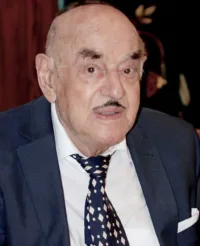Artur Brauner
BIOGRAPHY AND FILMOGRAPHY OF THE FILM PRODUCER ARTUR BRAUNER
Artur Brauner belongs to the few producers who shaped the German film history strongly over the last 70 years. He stands as a symbol for the German Entertainment Film industry of the 50s and 60s and at the same time is producer of some of the most significant West- German Films in the latest German history.
Born 1918 to the son of a wood merchant in Lodz (Poland), he graduated from grammar school. After his “A-levels” he studied at the Polytechnic until the German invasion of Poland. Together with his parents and four siblings he escaped to the former Soviet Union, where he was able to hide unidentified and survived the war. He lost 49 of his relatives due to the Nazis, his parents and three of his siblings immigrated to Israel.
Even before the Second World War, Artur Brauner was a huge film fan, seizing his chance after the war ended. After a brief consideration of immigrating to the US, he applied for a film company license in Berlin and after receiving it, he founded the CCC Film GmbH (Central Cinema Company) on the September 16th ,1946. His initial film with the new company is “Morituri” (1948), directed by Eugen York, starring Hilde Körber and Winnie Markus. The film reflects the dark German history together with his personal suffering from the Nazis. As post-war German audience is yet not ready for past German history, the film is a financial flop.
In 1949 Artur Brauner acquired 35.000 sqm property of a former manufacturing plant for poisoned gas in the north of Berlin, Spandau-Haselhorst. He established his first film studios on these grounds, with more than four studios and service buildings. His daughter, Alice Brauner, refurbished the studios in 2015/16. As an result the first German Netflix series “Dark” was shot till the end of March 2017 in the CCC studios.
In the Fifties Artur Brauner puts more emphasis on films that feed the audience’s desire for pure entertainment. He then achieved major success with “Dr. Mabuse” productions, films based upon short stories of Bryan Edgar Wallace, as well as cowboy films by the famous German writer Karl May. In those days (late 50s to mid 60s) the CCC Film studios were amongst the busiest in West Europe. Up until today more than 700 films were produced in Spandau-Haselhorst. Approx. 250 films are CCC’s own productions. One of the first productions in the newly erected studios is “Maharadscha wider Willen” (“Maharadga without desire”, 1950) with Olga Tschechowa.
Young German starlets shoot their very first films in the CCC studios. Romy Schneider starring in “Mädchen in Uniform” (“Girl in uniform”, 1958) as well as her last film, “La Passante du Sans-Souci” (“The stroller of Sanc Souci”, 1991) with Michel Piccoli, were productions by Artur Brauner. Between those two productions Artur Brauner produced numerous box office hits, which were viewed by millions of people. Big names such as O.W. Fischer, Maria Schell, Sonja Ziemann or Gerd Fröbe call the studios their home.
Artur Brauner invested the profits from his entertainment films into productions closer to his heart, due to his personal history. Amongst many, he produced “Die weisse Rose” (“The White Rose”) (1982) directed by Michael Verhoeven, starring Lena Scholze as Sophie Scholl. His “Hitlerjunge Salomon” (“EUROPA EUROPA”, 1989/90) starring Marco Hofschneider and Julie Delpy wins the Golden Globe and receives an Oscar nomination from the Academy Awards for best the screenplay. He produced “Hanussen” (1989) as well as “Babij Jar” (2003) a film about the true massacre of nearly 33.000 Jews near Kiev. His production “Der letzte Zug” (“The Last Train”, 2006) by director Joseph Vilsmaier and Dana Vávrová, which he produced together with his daughter Alice Brauner, tells the horrific story of a small group of Berliner Jews, who were dumped like thousands of other Jews into in a cattle box of a “special transport train” and deported from Berlin – Grunewald to Auschwitz during the very last days of the war. The further multi-award winning feature film productions “So ein Schlamassel” (“Oh What A Mess”, 2009/10) “Wunderkinder” (2011) and “Auf das Leben!” (“To Life!”, 2014) were produced mainly by Alice Brauner who will ensure the future of the established company.
Artur Brauner has produced more than 250 feature films. He is a prominent member of the Berlin Jewish community, bearer of the “Bundesverdienstkreuz” (“German National Cross”). In 2003 he received the “Goldene Kamera” (“Golden Camera”) from the Berlin Filmfestival “Berlinale”, as an award for his lifetime achievements. Amongst numerous other awards, he also has received two Golden Globes. His German/Italian co production “Der Garten der Finzi Conti” (“The Garden of Finzi-Continis”) was awarded an Academy Award Oscar in the category “Best Foreign Language Film”.
On the 11th of October, 2018 Artur Brauner was presented with the “Laemmle” sculpture of the Carl Laemmle Honorary Award by the Alliance of German Producers (Producers Alliance) and the Carl Laemmle birthplace Laupheim. It was presented to him, on the occasion of his 100th birthday on the 1st of August, 2018 in recognition of his outstanding life’s work as a film producer.
Artur Brauner has been married since 1947 with Theresa Albert, called Maria and is a father of four children. He lived and worked in Berlin.
Unfortunately Maria Brauner died in August 2017 and Artur Brauner in July 2019. They will never be forgotten. Baruch Dayan Ha’emet!
Young German starlets shoot their very first films in the CCC studios. Romy Schneider starring in “Mädchen in Uniform” (“Girl in uniform”) (1958) as well as her last film, “La Passante du Sans-Souci” (“The stroller of Sanc Soucci”) (1991) with Michel Piccoli, were productions by Artur Brauner. Between those two productions Artur Brauner produced numerous box office hits, which were viewed by millions of people. Big names such as O.W. Fischer, Maria Schell, Sonja Ziemann or Gerd Fröbe call the studios their home.
Filmography (Selection)
1948: Morituri
1949: Mädchen hinter Gittern
1950: Maharadscha wider Willen
1951: Sündige Grenze
1952: Der keusche Lebemann
1953: Hollandmädel
1954: Große Star-Parade
1955: Liebe, Tanz und 1000 Schlager (mit Caterina Valente und Peter Alexander)
1956: Du bist Musik
1957: Die Unschuld vom Lande
1958: Wehe, wenn sie losgelassen
1958: Mädchen in Uniform
1959: Der Tiger von Eschnapur – Regie: Fritz Lang
1959: Das indische Grabmal – Regie: Fritz Lang
1960: Der brave Soldat Schwejk – Regie: Axel von Ambesser (mit Heinz Rühmann)
1960: Die 1000 Augen des Dr. Mabuse – Regie: Fritz Lang (mit Gert Fröbe)
1961: Willy auf Sondermission
1961: Via Mala (mit Gert Fröbe und Edith Schultze-Westrum))
1961: Im Stahlnetz des Dr. Mabuse – Regie: Harald Reinl (mit Lex Barker)
1962: Die unsichtbaren Krallen des Dr. Mabuse – Regie: Harald Reinl (mit Lex Barker und Karin Dor)
1962: Das Geheimnis der schwarzen Koffer
1962: Im Schatten einer Nacht
1962: Der Tod fährt mit
1962: Das Ungeheuer von London-City
1962: Das Testament des Dr. Mabuse
1962: Der Fluch der gelben Schlange
1962: Sherlock Holmes und das Halsband des Todes
1963: Old Shatterhand
1963: Der Würger von Schloss Blackmoor
1963: Scotland Yard jagt Dr. Mabuse
1963: Der Henker von London
1964: Das Phantom von Soho
1964: Das 7. Opfer
1964: Die Todesstrahlen des Dr. Mabuse
1964: Der Schut (1964)
1964: Fanny Hill – Memoiren eines Freudenmädchens – Regie: Russ Meyer
1965: Der Schatz der Azteken
1965: Durchs wilde Kurdistan (1965)
1965: Die Pyramide des Sonnengottes
1965: Im Reiche des silbernen Löwen (1965)
1966: Die Nibelungen 1 – Siegfried – Regie: Harald Reinl (mit Uwe Beyer)
1967: Die Nibelungen 2 – Kriemhilds Rache – Regie: Harald Reinl
1967: Geheimnisse in goldenen Nylons
1968: Winnetou und Shatterhand im Tal der Toten (1968)
1968: Kampf um Rom 1 – Regie: Robert Siodmak (mit Orson Welles)
1968: Kampf um Rom 2
1969: Das Geheimnis der schwarzen Handschuhe
1970: Black Beauty
1970: Vampyros Lesbos – Erbin des Dracula – Regie: Jess Franco
1970: Sie Tötete in Ekstase – Regie: Jess Franco
1971: Der Todesrächer von Soho – Regie: Jess Franco
1971: Der Teufel kam aus Akasava – Regie: Jess Franco
1971: X 312 – Flug zur Hölle – Regie: Jess Franco
1972: Das Geheimnis des gelben Grabes
1972: Dr. M schlägt zu – Regie: Jess Franco
1974: Ein Unbekannter rechnet ab
1983: S. A. S. Malko – Im Auftrag des Pentagon
1983: Eine Liebe in Deutschland
1983: Blutiger Schnee
1987: Hanussen – Regie: István Szabó (mit Klaus Maria Brandauer und Erland Josephsson)
1990: Hitlerjunge Salomon – Regie: Agnieszka Holland (mit Marco Hofschneider und Julie Delpy)
1996: Von Hölle zu Hölle
2002: Babij Jar – das vergessene Verbrechen (mit Michael Degen und Axel Milberg)
2006: Der letzte Zug – Regie: Joseph Vilsmaier (mit Gedeon Burkhard und Sibel Kekilli)
Awards (Selection)
1961: Bambi für Die Ratten
1963: Zürcher Filmpreis für Die Ehe des Herrn Mississippi
1965: Goldene Leinwand für Old Shatterhand
1965: Goldene Leinwand für Der Schut
1967: Goldene Leinwand für Die Nibelungen
1970: Goldener Bär für Der Garten der Finzi Contini
1972: Oscar (Bester nicht englisch-sprachiger Film) für Der Garten der Finzi Contini
1983: IFF Gijon: 3. Preis für Nach Mitternacht
1983: Deutscher Filmpreis: Filmband in Silber für Die weiße Rose
1985: Oscar-Nominierung für Bittere Ernte
1990: Deutscher Filmpreis: Filmband in Gold für langjähriges und hervorragendes Wirken im deutschen Film
1992: Golden Globe für Hitlerjunge Salomon
1993: Bundesverdienstkreuz I. Klasse
1996: DIVA-Award (gemeinsam mit Franz Seitz)
1996: Scharlih-Preis, die bekannteste Auszeichnung, die mit dem Namen Karl May verbunden ist
2003: Goldene Kamera
2010: Stern auf dem Boulevard der Stars in Berlin
2012: Ehrenmitgliedschaft in der Produzentenallianz
Literature
Artur Brauner: “Mich gibt’s nur einmal” München, Berlin, (Herbig, 1976)
Claudia Dillmann-Kühn: „Artur Brauner und die CCC”, (erschienen in der Schriftenreihe des Deutschen Filmmuseums Frankfurt am Main, 1990)























